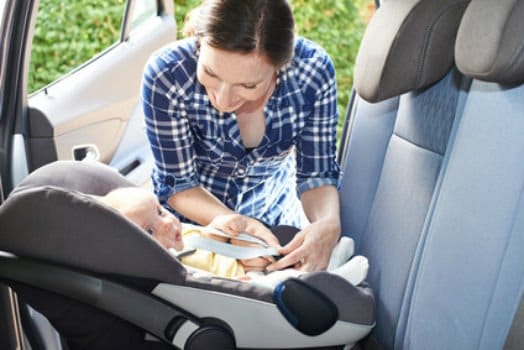Main Takeaways
- Children under 1 year should ride in rear-facing car seats; a child shouldn’t ride in forward-facing seats until he or she has reached 1 year old and weighs 40 pounds.
- All children under the age of 8 are required to use a car seat or booster seat, and to sit in the backseat of the car. Children under age 8 who are over 4’9” tall (57”) are exempted.
- The car seat or booster seat must be in the rear seat, be appropriate for the child’s weight and height, and be properly installed and used according to the instructions.

What are Georgia Car Seat Laws?
Car accidents are a leading cause of death and injury to children in Georgia. On average, around 1,300 children die in automobile accidents per year, and 179,000 are injured. Many of these injuries and deaths are facilitated by improper car and booster seat use. In fact, car and booster seats, when used correctly, protect infants from injury 71% of the time, and children aged 1 to 4 54% of the time.
Since car seats play such an important role in protecting children in auto accidents, the state of Georgia has specific laws regulating how car seats should be used.
We published an Atlanta accident map to determine where accidents, injuries, and fatalities are most common on Atlanta roads. Be sure to pay particular attention when you are driving, walking, or riding in these areas.
Which ages need car seats?
By law, all children under the age of 8 are required to use a car seat or booster seat, and to sit in the backseat of the car. Children under age 8 who are over 4’9” tall (57”) are exempted.
Which vehicles apply?
Children must use car seats in passenger automobiles, vans, and pickup trucks. In other words, the law applies to all vehicles except for taxis and public transit.
Specifications
The car seat or booster seat must be in the rear seat, be appropriate for the child’s weight and height, and be properly installed and used according to the instructions. Among other things, this means that both the lap and shoulder belts should be used to secure booster seats.
Exceptions
Children taller than 4’9” may ride without a car or booster seat, even if they are younger than 8.
Additionally, exceptions can be made for children with a medical or physical condition that prevents them from being restrained by seat belts, provided the child’s parent or guardian has a written statement from the child’s doctor.
Children under age 8 who weigh 40 pounds or more may only use a lap belt instead of a car or booster seat in vehicles that are not equipped with shoulder belts, and in situations when all seats with lap and shoulder belts in the car (excluding the driver’s seat) are occupied by other children.
If a vehicle doesn’t have a backseat, or if other children are occupying the backseat, a child under age 8 may sit in the front seat with a car or booster seat, provided they weigh 40 pounds or more.
Fines
Fines can be up to $50 for a first conviction, and up to $100 for subsequent convictions.
Safety Recommendations
While not required by law, there are several practices you can follow to give your child maximum protection when riding in a vehicle. Children under 1 year should ride in rear-facing car seats; a child shouldn’t ride in forward-facing seats until he or she has reached 1 year old and weighs 40 pounds. Additionally, children under age 13 should ride in the backseat.
Car seats with the five-point harness are generally the most effective, though all car and booster seats made in the U.S. must pass federal safety standards.



